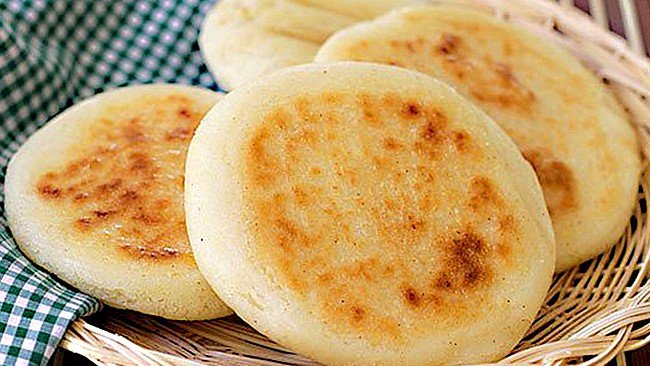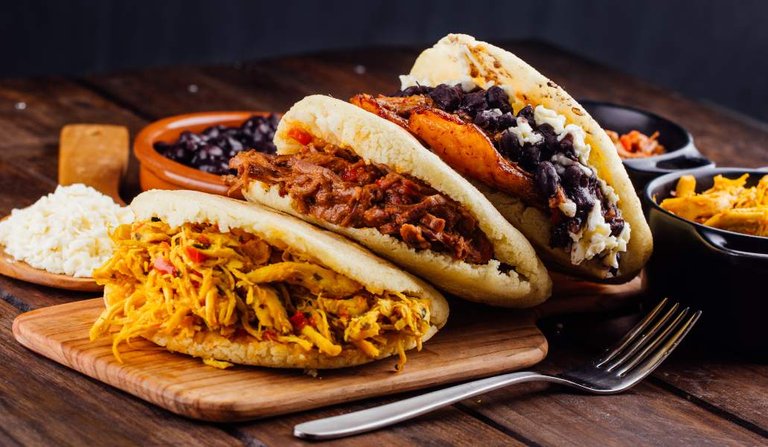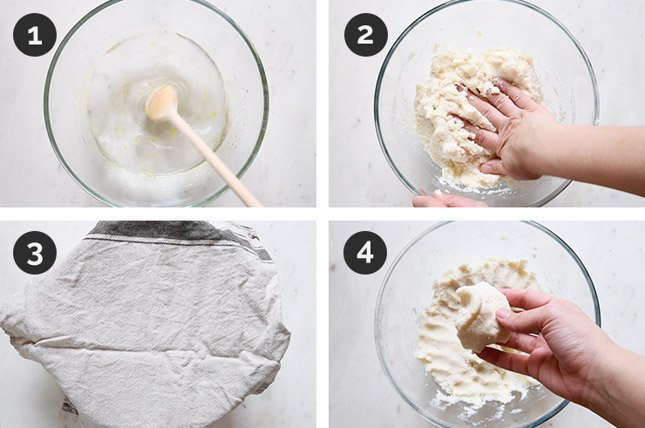El arte de hacer una arepa [ESP-ENG] The art of making arepas.
Según mi criterio y se que muchos estarán de acuerdo, no hay nada mas venezolano que una arepa. Nuestro desayuno por excelencia ha estado en nuestra gastronomía por siglos, desde los tiempos precolombinos, es una especie de pan preparado con harina de maíz seco molido, y que se cocina de forma circular y aplanada, frita o tostada en un budare, una especie de plancha metálica gruesa, y que en nuestro país se puede rellenar prácticamente con cualquier acompañante salado, todo esta en la imaginación.
According to my criteria and I know that many will agree, there is nothing more Venezuelan than an arepa. Our breakfast or dinner par excellence has been in our gastronomy for centuries, since pre-Columbian times, it is a kind of bread prepared with ground dry corn flour, and that is cooked in a circular and flattened shape, fried or toasted in a budare, a kind of thick metal plate, and that in our country can be filled with virtually any salty side dish, cheese, chicken, meat, eggs, everything is in the imagination.

Fuente / Source
Justo mientras escribo esto, acabo de comerme una, su origen se remonta al periodo arcaico, aproximadamente en el año 8000 A.C., creada por los indígenas precolombinos del norte de sudamerica, si fue en Colombia o en Venezuela donde se creó, la verdad es desconocida, pero las diferencias entre ambas versiones de la arepa son muy marcadas, principalmente porque las nuestras se comen rellenas. Según Mariano Picon Salas, escritor venezolano, la palabra ''Arepa'' proviene de la voz erepa que significa maíz en la lengua indigena de los cumanagotos, una tribu venezolana y por ello, le atribuye el origen de este alimento a nuestro pais, pero como dije antes, no hay datos concreto sobre el tema y por ello suele ser siempre un debate.
Its origin dates back to the archaic period, approximately 8000 B.C., created by the pre-Columbian Indians of northern South America, it's mean Colombia and Venezuela, whether it was in Colombia or in Venezuela where it was created, the truth is unknown, but the differences between the two versions of the arepa are very marked, mainly because ours are eaten stuffed. According to Mariano Picon Salas, a Venezuelan writer, the word ''Arepa'' comes from the word erepa which means corn in the indigenous language of the Cumanagotos, a Venezuelan ethnic group tribe, and therefore, he attributes the origin of this food to our country, but as I said before, there is no concrete data on the subject and therefore it is always a debate.

Fuente / Source
Su preparación es bastante fácil y muy económica, un kilo de harina precocida cuesta alrededor de 1$, y su preparación solo necesita agua y sal, la masa tiene una textura firme pero manejable y ello da espacio a la improvisación, se le pueden agregar mas ingredientes para darle valor a la masa, como avena, lino, arroz o cualquier otro tipo de cereal al gusto, en proporción va 1 medida de harina de maíz y 1.25 de agua ademas de unos 10 gramos de sal, la receta básica es así:
- 2 tazas de harina.
- 2 tazas y media de agua.
- 1 cucharadita de sal.
Se agrega el agua en un bowl y se va agregando gradualmente la harina mientras vamos amasando con las manos, se amasa por 2 minutos y se deja reposar por otros 5 minutos para que se termine de hidratar la harina, si llega a quedar muy firme la masa, se le puede agregar agua poco a poco repitiendo el proceso, las arepas se forman con la mano y se cocinan en un sarten o plancha que sea de material grueso, a fuego lento, unos 5 minutos por lado, hasta que estén cocidas por dentro, también se pueden hacer fritas e incluso, hay personas que las cocinan hervidas o al vapor. La arepa debe comerse inmediatamente después de prepararla, ya que si se enfría, se endurece y pierde calidad, pueden prepararse y guardarse dentro de un bowl cubiertas por un paño limpio. Para el relleno se puede utilizar carne, pollo, pescado, queso, huevos y un sin fin de rellenos mas, ademas de mantequilla, que se usa para darle humedad y sabor, mis rellenos favoritos son el atún, fresco o en lata, mezclado con cebolla y tomate crudo, un poco de cilantro y un poco de mayonesa, o también pollo mezclado con un poco de mayonesa, cebolla y aguacate, este ultimo es llamado de forma popular como ''Reina Pepiada'', y por supuesto, queso, mantequilla y jamón, una combinación que no falla jamas.
Its preparation is quite easy and very economical, a kilo of precooked flour costs about 1$, and its preparation only needs water and salt, the dough has a firm but manageable texture and this gives room for improvisation, you can add more ingredients to give value to the dough, such as oats, flax, rice or any other type of cereal to taste, in proportion goes 1 measure of corn flour and 1.25 of water plus about 10 grams of salt, the basic recipe is as follows:
- 2 cups of flour.
- 2 and a half cups of water.
- 1 teaspoon of salt.
Add the water in a bowl and gradually add the flour while kneading with your hands in an enveloping way and trying to eliminate any lumps that may form, knead for 2 minutes and let stand for another 5 minutes to finish hydrating the flour, if the dough becomes too firm, you can add water little by little repeating the process, the arepas are formed by hand by first making a ball with the dough and then flattening it little by little, the sides should not be broken so you have to do it gently, you can help with two sheets of plastic, once formed are cooked in a pan or griddle that is thick material, over low heat, about 5 minutes per side, until cooked inside, can also be done fried and even, some people cook them boiled or steamed. The arepa should be eaten immediately after preparing it, because if it cools down, it hardens and loses quality. For the filling you can use meat, chicken, fish, cheese, eggs and an endless number of other fillings, besides butter, which is used to give it moisture and flavor, my favorite fillings are tuna, fresh or canned, mixed with onion and raw tomato, a little cilantro and a little mayonnaise, or chicken mixed with a little mayonnaise, onion and avocado, this last one is popularly called ''Reina Pepiada'', and of course, cheese, butter and ham, a combination that never fails.

Fuente / Sourcce
El maiz es un alimento muy importante en la nutrición venezolana y eso queda demostrado con la arepa, es extremadamente raro encontrar a un venezolano que afirme no haber probado nunca una y menos aun uno que diga que no le gustan, ademas, como si se tratase de un don genético, los venezolanos no aprendemos a hacer arepas, simplemente un día vamos a la cocina y descubrimos que ya sabemos hacerlo, es como si naciéramos con esa habilidad desbloqueada, yo migre a Ecuador y tuve convivencia con un amigo argentino que era fanático de las arepas y me provocaba mucha risa ver como las preparaba porque algo que yo podía hacer con los ojos cerrados y que ademas nadie me enseñó, yo solo lo sabia, a el le costaba un montón, sobre todo darle la forma característica a la arepa, pero no hay que perder los ánimos, con practica se llega al punto correcto y podrás disfrutar de esta maravilla gastronómica cuando desees, ademas, por si te lo preguntas, también se pueden preparar como postre, añadiendo azúcar y anís a la masa, y friéndolas en aceite caliente, como sea son una delicia.
Corn is a very important food in Venezuelan nutrition and that is demonstrated with the arepa, it is extremely rare to find a Venezuelan who claims to have never tried one and even less one who says he does not like them, besides, as if it were a genetic gift, Venezuelans do not learn to make arepas, just one day we go to the kitchen and discover that we already know how to do it, it is as if we were born with that ability unlocked, I migrated to Ecuador and I lived with an Argentinean friend who was a fan of arepas and it made me laugh a lot to see how he prepared them because something that I could do with my eyes closed and that nobody taught me, I just knew it, it was hard for him, especially to give the characteristic shape to the arepa, and then fighting with the frying pan because it was burning, it was very funny, but do not lose heart, with practice you get to the right point and you can enjoy this gastronomic wonder whenever you want and with the filling of your choice, also, in case you wonder, can also be prepared as a dessert, adding sugar and anise to the dough, and frying them in hot oil, however they are a delight.

Fuente / Source





Seguramente los platillos son deliciosos, como me gustaría degustarlos.
Me encantan las arepas , y aunque no soy venezolana me fascinan!! La reina pepiada, sencillamente deliciosa